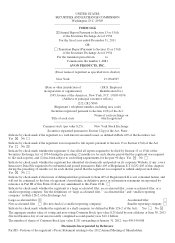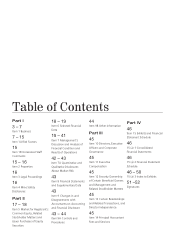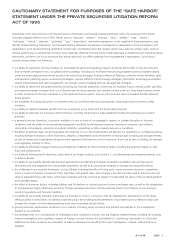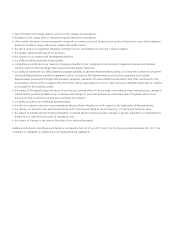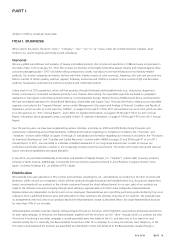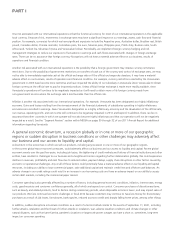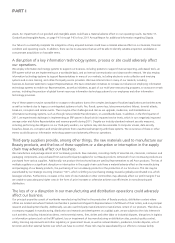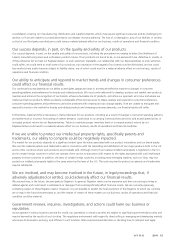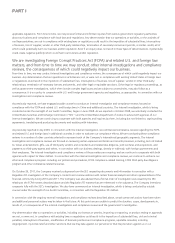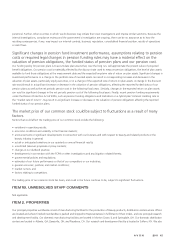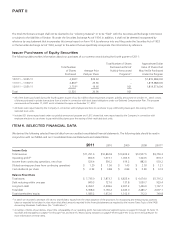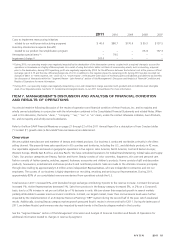Avon 2011 Annual Report Download - page 17
Download and view the complete annual report
Please find page 17 of the 2011 Avon annual report below. You can navigate through the pages in the report by either clicking on the pages listed below, or by using the keyword search tool below to find specific information within the annual report.Our business is conducted worldwide primarily in one channel, direct selling.
Our business is conducted worldwide, primarily in the direct-selling channel. Sales are made to the ultimate consumer principally through
approximately 6.4 million active independent Representatives worldwide. There is a high rate of turnover among Representatives, which is a
common characteristic of the direct-selling business. As a result, in order to maintain our business and grow our business in the future, we
need to recruit, retain and service Representatives on a continuing basis and continue to innovate the direct-selling model. Consumer
purchasing habits, including reducing purchases of beauty and related products generally, or reducing purchases from Representatives or
buying beauty and related products in channels other than in direct selling, such as retail, could reduce our sales, impact our ability to
execute our global business strategy or have a material adverse effect on our business, financial condition and results of operations. If our
competitors establish greater market share in the direct-selling channel, our business, financial condition and operating results may be
adversely affected. Furthermore, if any government bans or severely restricts our business method of direct selling, our business, financial
condition and operating results may be adversely affected.
Our ability to conduct business, particularly in international markets, may be affected by
political, legal, tax and regulatory risks.
Our ability to capitalize on growth, particularly in new international markets, and to maintain the current level of operations, particularly in
our existing international markets, is exposed to various risks, including:
• the possibility that a foreign government might ban or severely restrict our business method of direct selling;
• the possibility that local civil unrest, economic or political instability, changes in macro-economic conditions, changes in diplomatic or
trade relationships or other uncertainties might disrupt our operations in an international market;
• the lack of well-established or reliable legal systems in certain areas where we operate;
• the adoption of new U.S. or international tax legislation or exposure to additional tax liabilities;
• the possibility that a government authority might impose legal, tax or other financial burdens on our Representatives, as direct sellers, or
on Avon, due, for example, to the structure of our operations in various markets; and
• the possibility that a government authority might challenge the status of our Representatives as independent contractors or impose
employment or social taxes on our Representatives.
For example, in 1998, the Chinese government banned direct selling, but, subsequently in April 2005, the Chinese government granted
approval for us to proceed with a limited test of direct selling in certain areas. The Chinese government later issued direct-selling regulations
in late 2005, and we were granted a direct-selling license by China’s Ministry of Commerce in late February 2006, which allowed us to
commence direct selling under such regulations. However, there can be no assurance that these and other regulations and approvals will not
be rescinded, restricted or otherwise altered, or that other regulations and approvals will not be adopted, which may have a material adverse
effect on our business in China. There can be no assurance that we will be able to successfully transition and evolve our business in China in
connection with the development and evolution of the direct selling business in that market and successfully operate using a direct-selling
model permitted in that market, or that we will experience growth in that or other emerging markets. We may encounter similar political,
legal and regulatory risks in other international markets in our portfolio.
We are also subject to the adoption, interpretation and enforcement by governmental agencies in the United States and abroad of other
laws, rules, regulations or policies, including any changes thereto, such as restrictions on trade, import and export license requirements,
privacy and data protection laws, records and information management, e-invoicing, and tariffs and taxes, which may require us to adjust
our operations and systems in certain markets where we do business. For example, privacy and data protection laws are subject to frequently
changing rules and regulations, which may vary among the various jurisdictions where we operate. If we are unable to adhere to or
successfully implement processes in response to changing regulatory requirements, our business and/or reputation may be adversely
affected. We cannot predict with certainty the outcome or the impact that pending or future legislative and regulatory changes may have on
our business in the future.
We are subject to financial risks related to our international operations, including exposure to
foreign currency fluctuations.
We operate globally, through operations in various locations around the world, and derive approximately 83% of our consolidated revenue
from our operations outside of the U.S.
A V O N 2011 9


